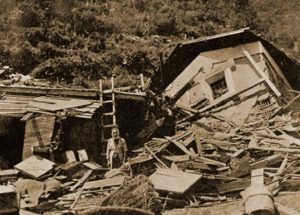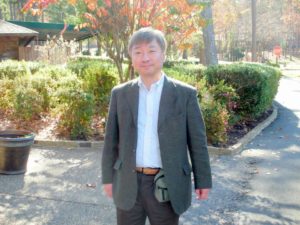‘Pen Pal’ in Japan Aids My Book Research
This is Ichiro Fudai. We’ve never met. But he and I have corresponded online for many weeks, after he learned about my book project on Eliza Scidmore through a TV program that aired during my research trip to Japan in 2013.
Ichiro, who has visited the United States and has an excellent command of English, lives in Japan’s Iwate Prefecture. He first contacted me about a connection to Eliza Scidmore’s story in his hometown of Hanamaki.
A close friend of Eliza Scidmore late in her life, Inazo Nitobe, hailed from Hanamaki. Ichiro, a manager for the city and a keen history buff, wrote to inform me about a local museum on Dr. Nitobe.
Nitobe, an agronomist by training, became a prominent Japanese statesman and worked for the new League of Nations at its headquarters in Geneva, Switzerland.
Geneva is where Eliza Scidmore spent her final years. She socialized with Nitobe and his American-born wife, Mary.
Inazo Nitobe became famous in the West for his book Bushido: The Soul of Japan. Analogous to a code of chivalry, bushido was the way of the samurai, emphasizing traits of loyalty, discipline and honor. Published in 1899, the book became hugely popular and influenced people like Teddy Roosevelt.

This photo in the September 1896 “National Geographic” accompanied an article by Eliza Scidmore on a deadly tsunami along Japan’s Sanriku coast.
Another link to Ichiro’s native region: In September 1896, Eliza Scidmore published an article in National Geographic on a horrific tsunami that occurred the previous June off the Sanriku coast of northeastern Japan.
The disaster killed 23,000 people and wiped out entire fishing villages along a 170-mile stretch of shoreline.
The term tsunami was not familiar to Americans at the time, so Scidmore’s article was one of the earliest uses of the term in the English language.
The tsunami occurred not far from where Ichiro lives.

Inazo Nitobe was, like my great-grandfather Torajiro Watase, a graduate of the Sapporo Agricultural College (Hokkaido University – where there is a bust of him on the campus) and likely studied under science professors sent over from the University of Massachusetts in Amherst. He was Japan’s pre-eminent western educator in the 20th century — and was the president of my other’s alma mater, Tokyo Christian Women’s College before World War II — no doubt influenced by his American Quaker wife in his concern for girls’ education.
In addition to Bushido, he wrote a book called “Jinsei Dokuhon” (A Primer of Life) which perhaps should be translated. I will read it and let you know!
Best Regards,
Eiko
PS Would you be so kind as to put me in touch with your pen pal? My paternal grandmother – who was schooled by Baptists in Sendai (Morioka Prefecture, next to Iwate) – did relief work during the great tsunami he writes about!
Hi, Eiko.
I’ll send along Ichiro Fudai’s email address offline. He’ll probably love hearing from you, as he’s quite an enthusiastic sleuth of local history.
Diana